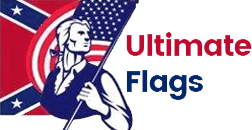Home » Colombia Flag
Product Categories

Colombia Flag
Show your love for Colombia with our high-quality flag made of durable nylon. Perfect for indoor or outdoor use. Order now from Ultimate Flags.
The Colorful World of the Colombian Flag…
Table of Contents
Country Flag of Colombia
History of the Colombian Flag
Symbolism of the Colombia Flag
Why Buy a Colombian Flag from UltimateFlags.com?
Colombia Flag -Interesting Facts and Questions
A symbol of Unity
Country Flag of Colombia
Welcome to the vibrant world of the Colombian flag! Known for its striking colors and rich history, the flag of Colombia is not just a national symbol but a banner of pride and cultural identity.
History of the Colombian Flag
The Colombian flag has a fascinating history. It originated from the time of Gran Colombia, a republic that encompassed much of northern South America. Let’s explore how the flag evolved from its inception to becoming the symbol of the Republic of Colombia.
Symbolism of Colombia’s Flag
Each color of the Colombian flag holds deep meaning. The yellow represents the gold found in Colombia, blue symbolizes the seas on its shores, and red stands for the blood shed in achieving freedom. But there’s more to these colors than meets the eye.
Why Buy a Colombian Flag from UltimateFlags.com?
UltimateFlags.com offers high-quality Colombian flags in various materials like polyester and nylon, ideal for any setting. Whether flying high on a flagpole or displayed in your home, find out why a flag from UltimateFlags.com is a special purchase.
What is Colombia’s Capital City?
Did you know that Bogota is not just the capital of Colombia but also a cultural hub where the flag flies proudly? Yes, the bright and vibrant flag flies proudly in Bogota, Colombia.
The Colombia Flag: A Symbol of Unity
From the bustling streets of Bogota to the serene landscapes of the Colombian countryside, the flag of Colombia is a symbol of unity and pride. Let’s embrace this beautiful banner and what it represents.
1. What do the colors of the Colombian flag represent?
The yellow symbolizes the riches of the country, the blue the seas on its shores, and the red represents the blood shed for independence.
2. When was the current design of the Colombian flag adopted?
The current design was officially adopted on November 26, 1861.
3. Who designed the Colombian flag?
The flag was inspired by Francisco de Miranda, a Venezuelan general who played a key role in Latin America's independence struggle.
4. Has the Colombian flag changed over the years?
Yes, it has undergone several changes, especially during the early 19th century, before settling on its current design.
5. What is the significance of the yellow color being larger than the other two?
The larger yellow band represents the natural wealth of Colombia and its sovereignty, while the other two colors are symbolic of its history and geography.
6. Is there an official flag for the President of Colombia?
Yes, the President of Colombia has an official flag that includes the national coat of arms.
7. How is the Colombian flag used in national celebrations?
It is prominently displayed during national holidays, independence celebrations, and other significant national events.
8. What are the official dimensions of the Colombian flag?
The flag's width-to-length ratio is 2:3, with each color band having specific dimensions.
9. Are there any specific rules for flying the Colombian flag?
Yes, there are protocols for flag handling and display, including its positioning relative to other flags and how it should be raised and lowered.
10. How does the Colombian flag differ from the flags of Ecuador and Venezuela?
While all three share similar colors due to their historical connection, the shades and designs (such as coat of arms) differ.
11. Can the Colombian flag be used for commercial purposes?
Yes, but it should be done respectfully and in accordance with national regulations regarding the flag's image.
12. What is the historical connection between the Colombian flag and Gran Colombia?
The flag is derived from the flag of Gran Colombia, the short-lived republic that once included Colombia, Ecuador, Panama, and Venezuela.
13. Is the Colombian flag a symbol of peace?
Yes, it is often seen as a symbol of peace, particularly in the context of Colombia's recent history and peace efforts.
14. How is the Colombian flag represented in the country's coat of arms?
The flag's colors are represented in the shield of the coat of arms, symbolizing Colombia's independence and sovereignty.
15. What is the protocol for flying the Colombian flag at half-mast?
Flying the flag at half-mast is a sign of mourning or distress and is done under specific government directives.
16. Are there any specific days when the Colombian flag must be displayed?
Yes, it is especially important on national holidays like Independence Day (July 20) and Battle of Boyacá Day (August 7).
17. Does the Colombian flag have any religious significance?
While not inherently religious, it is sometimes used in religious and cultural ceremonies, symbolizing national unity.
18. How do Colombians perceive their national flag?
It is widely regarded as a symbol of national pride, unity, and the rich cultural heritage of Colombia.
19. Can the Colombian flag be modified?
Officially, no. The flag's design is set by law and any modification for official use is not permitted.
20. What is the importance of the flag in Colombian education?
It is used to teach students about national history, values, and patriotism.
21. Are there any famous monuments dedicated to the Colombian flag?
Yes, there are several monuments and memorials throughout Colombia that honor the flag and its significance.
22. How is the Colombian flag used in international events?
It represents Colombia in international events like sports competitions, diplomatic meetings, and cultural exchanges.
23. Has the Colombian flag been involved in any significant historical events?
Yes, it has been a symbol in many key moments in Colombia's history, including its independence struggle and peace processes.
24. What is the role of the flag in Colombian diplomatic missions?
It is used to represent and assert Colombia's national identity and presence in the international community.
25. How is the Colombian flag viewed globally?
Globally, it is recognized as a symbol of Colombia's rich history, diverse culture, and its aspirations as a nation.






